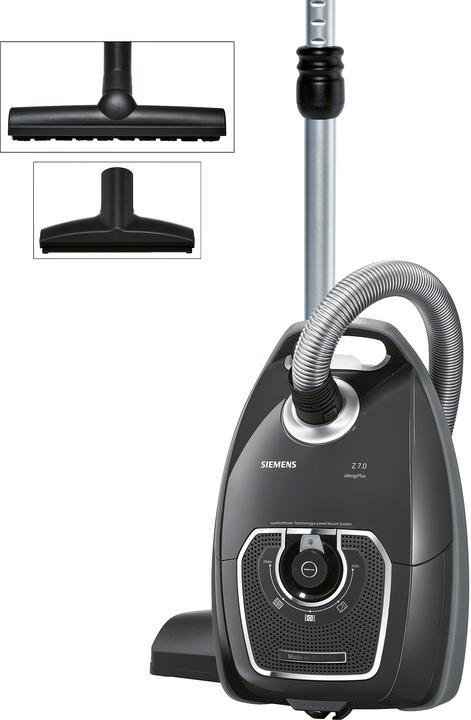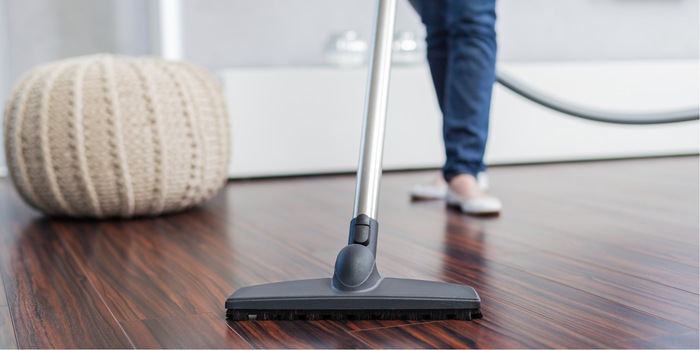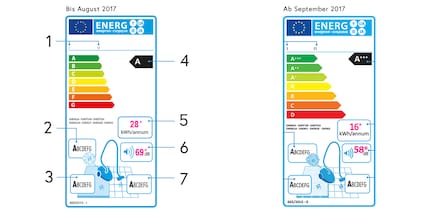

A lot of dust for nothing? Energy label for hoovers
For some years now, manufacturers of hoovers have had to disclose the energy efficiency of their appliances. Since 1 September 2017, there has also been a new regulation regarding wattage. Appliances have become more economical since the introduction of the label, which means that the labelling has been extended from "A+" to "A++". But what do the various specifications on the label really say about the respective dust eaters? And how high are the energy savings of a more efficient appliance really?
Why do we have energy labels?
The European Union wants to make a significant article on climate protection targets by 2020 - and Switzerland is following suit. Hoovers, like other household appliances, must be labelled with an energy label. The introduction of mandatory labelling for various appliances will prevent companies from producing energy-hungry appliances. This will make it easier for customers to save energy costs and protect the environment. In addition, energy labelling allows customers to make purchasing decisions based on comparable facts and compare appliances more easily.
Energy efficiency label explained
In our online shop, you will find the energy efficiency labels next to the product images. Not only can you quickly find all the relevant information, but you can also compare the products with each other. Filtering also helps you to find efficient appliances. The label is always structured in exactly the same way. Here is a brief explanation:

1. product name
Here you will find the brand name and the exact model name
.
2. dust emission class
The dust emission class is used to assess the quality of the air released into the room. Class "A" is the best, "G" stands for the class with the worst performance. If a hoover is categorised in class "A", less than 0.02% of the vacuumed dust is released back into the room through the exhaust air. In class "B", for example, it is 0.02 - 0.08%.
3rd cleaning class on carpets
Like the dust emission class, the cleaning class on carpets is given as a per cent. This cleaning class indicates the maximum dust pick-up performance of the hoover on a test carpet. Here too, the scale ranges from A - G. Only those appliances that can pick up at least 9% of the dust from the carpet are categorised in class "A". The dust pick-up drops by 4% for each class, meaning that hoovers in group "G" only pick up 67% of the dust.
4th energy efficiency class
For appliances launched on the market by August 2017
The energy efficiency classes are indicated by the letters A - G, with "A" being very efficient and "G" being very inefficient. The energy consumption, stated in kWh/year, increases by around 6 kWh per energy efficiency class. A hoover in energy efficiency class "A" therefore consumes 36 kWh less per year than a hoover in class "G" for the same use.
Devices with market launch from September 2017
The energy efficiency classes will be specified from A+++ to G from September 2017. The new values "A+", "A++" and "A+++" serve to differentiate more precisely between economical appliances. An appliance in the "A+++" class now only consumes a maximum of 10 kWh per year. Here, too, the gradation occurs after around 6 kWh. An "A++" vacuum cleaner consumes a maximum of 16 kWh per year.
5. Average annual energy consumption
The average annual energy consumption of a hoover is given in "kWh/year". This value is based on an average usage area of 87m² with 50 vacuuming processes per year. The energy consumption value can therefore change depending on the use of the hoover and depends on the size of your home and the number of vacuuming operations carried out.
6. noise level
A final class on the energy label is the noise level of the hoover, which is given in decibels (dB). This value should be between 80 and 85 and corresponds roughly to the value of a standard hair dryer. The higher the decibel level, the louder your hoover is.
7th cleaning class on hard floors
The cleaning class on hard floors is also an important criterion. The cleaning performance on hard floors is given as a per cent and corresponds to the approximate dust pick-up performance on a test wooden board with joints. A hoover can fall into one of the seven different cleaning classes (A - G). Dust pick-up decreases by three per cent from class to class. For example, a hoover in cleaning class "A" has an 18% higher cleaning performance than a vacuum cleaner in class "G".
Significant changes in September 2017
As appliances are becoming increasingly energy-efficient and many models fall under energy efficiency class "A", it makes sense to differentiate between the more economical appliances. Additional classes have therefore been developed, similar to energy labels for large appliances. The models that came onto the market after September 2017 were labelled according to the new scheme.
The new regulations for hoovers include the following points:
- The annual energy consumption must be less than 43kWh. According to EU regulations for 50 cleaning processes per year, for an average household of 87m².
- The power consumption must be less than 900 W.
- Dust pick-up on carpets must be at least 75% - on hard floors 98%.
- Dust emission must not exceed 1%.
- The noise level must not exceed 80 dB.
Devices that do not meet these requirements and are already on the market may still be sold until 31 August 2019.

Is it worth switching to a more economical model?
The main question - despite the energy efficiency award - is whether it is worth switching to a more economical appliance. I have calculated the potential electricity savings for this.
Assumptions:
- 50 cleaning processes (analogue EU regulation) per year, for an average household of 87m².
- Electricity price 20 Rp./kWh.
Example calculation A-Class:
- Energy efficiency class A, 27 kWh per year
- Energy costs: 27 x 20 cents = 5.40 francs
Example calculation G-Class:
- Energy efficiency class G, 58 kWh per year
- Energy costs: 58 x 20 cents = 11.60 francs
Over the course of a year, the difference between an "A" class hoover and a "G" class model is 6.20 francs and 31 kWh. Doesn't sound like an incredible amount for a household. But let's take this calculation example a step further and work out the electricity savings for the whole of Switzerland. Of course, these are assumptions. However, to illustrate what a difference it can make, I personally found it very interesting.
How much electricity can the whole of Switzerland save?
Since not all Swiss households currently have a hoover in the worst energy efficiency class "G", I calculate with half of the possible savings from the calculation above per year/household (15.5 kWh over 1 year per hoover). This means that a possible saving over 1 year across all Swiss households (as of 2015: 3.6 million) would actually be a whopping 55,800,000 kWh.
How often does an electric car drive around the world in this way?
A Tesla "Model S60" consumes 18.1 kWh per 100 km, according to the car manufacturer's website. With the annual savings calculated above, the Tesla could circumnavigate the globe around 7,707 times. In financial terms, all Swiss households would save a total of 11,160,000 francs a year - without switching to an "A+++" class hoover.

.
Should you buy a new hoover now?
The answer to the question of whether it's worth switching to an energy-efficient hoover in the long term probably answers itself. At the latest when your old vacuum cleaner breaks down, you might remember this calculation.
If you're worried about spending more time cleaning your home with a more economical hoover, you can rest assured. It's not just the number of watts that determines good suction power, but also the design of the appliance. This also includes the motor and turbine efficiency as well as the quality of the individual parts such as the brush head, suction tube and air ducts. If a better motor and good seals are installed, the hoover can provide just as good a cleaning performance with less wattage.
To the entire range of vacuum cleaners
Friends, family, cats and good wine are my lifeblood.
Interesting facts about products, behind-the-scenes looks at manufacturers and deep-dives on interesting people.
Show all